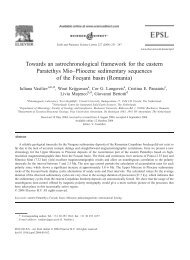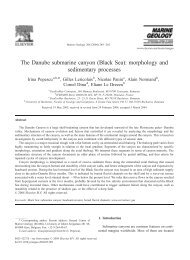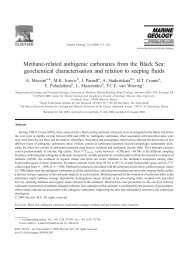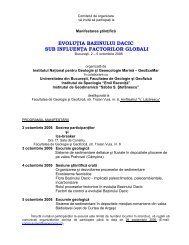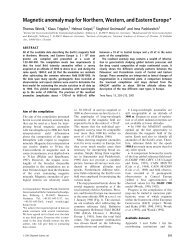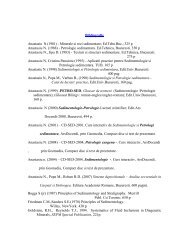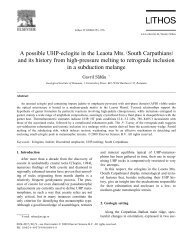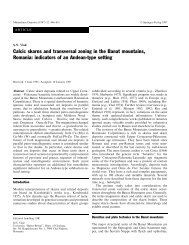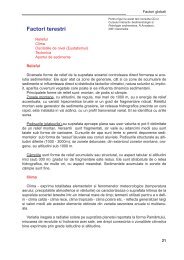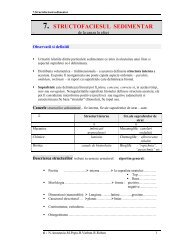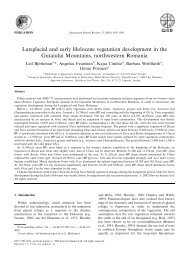Holocene vegetational history of the Apuseni ... - geo.edu.ro
Holocene vegetational history of the Apuseni ... - geo.edu.ro
Holocene vegetational history of the Apuseni ... - geo.edu.ro
You also want an ePaper? Increase the reach of your titles
YUMPU automatically turns print PDFs into web optimized ePapers that Google loves.
1482<br />
A. Bodnariuc et al. / Quaternary Science Reviews 21 (2002) 1465–1488<br />
Chenopodiaceae and Aste<strong>ro</strong>ideae became more frequent.<br />
This early impact is not surprising when<br />
considering <st<strong>ro</strong>ng>the</st<strong>ro</strong>ng> situation <st<strong>ro</strong>ng>of</st<strong>ro</strong>ng> <st<strong>ro</strong>ng>the</st<strong>ro</strong>ng> site along a valley<br />
allowing easy access to <st<strong>ro</strong>ng>the</st<strong>ro</strong>ng> flat areas <st<strong>ro</strong>ng>of</st<strong>ro</strong>ng> mid elevation.<br />
F<strong>ro</strong>m <st<strong>ro</strong>ng>the</st<strong>ro</strong>ng> available archaeoch<strong>ro</strong>nological data, this first<br />
presence might be attributed to <st<strong>ro</strong>ng>the</st<strong>ro</strong>ng> first Neolithic<br />
occupations in Transylvania (Gura Baciului, Ocna<br />
Sibiului, Starcevo–Cris III–IV Cultures) dated between<br />
7850 and 7350 cal BP (Laza<strong>ro</strong>vici, 1993; Demoulle, 1998;<br />
Mantu, 1998). Settlements <st<strong>ro</strong>ng>of</st<strong>ro</strong>ng> <st<strong>ro</strong>ng>the</st<strong>ro</strong>ng>se people were present<br />
o100 km f<strong>ro</strong>m <st<strong>ro</strong>ng>the</st<strong>ro</strong>ng> studied area, <st<strong>ro</strong>ng>the</st<strong>ro</strong>ng> anth<strong>ro</strong>pogenic<br />
indicators suggesting that, at that time, g<strong>ro</strong>ups had<br />
already begun to travel over <st<strong>ro</strong>ng>the</st<strong>ro</strong>ng> mountain. At Bergerie,<br />
during <st<strong>ro</strong>ng>the</st<strong>ro</strong>ng> same period, anth<strong>ro</strong>pogenic indicators such<br />
as increases in Cichorioideae and Rumex are also found<br />
near 7600 cal BP. The local impact seems limited. The<br />
sedimentation rate which was 0.6 mm/yr between ca<br />
7800 and 7600 cal BP was only 0.17 mm/yr between 7600<br />
and 4570 cal BP.<br />
The age <st<strong>ro</strong>ng>of</st<strong>ro</strong>ng> this first palynological evidence <st<strong>ro</strong>ng>of</st<strong>ro</strong>ng><br />
Romanian Neolithic husbandry agrees with <st<strong>ro</strong>ng>the</st<strong>ro</strong>ng> presence<br />
<st<strong>ro</strong>ng>of</st<strong>ro</strong>ng> nume<strong>ro</strong>us dated archaeological sites in <st<strong>ro</strong>ng>the</st<strong>ro</strong>ng> Balkans<br />
between 8900 and 6800 cal BP (Willis, 1994; Willis and<br />
Bennett, 1994) and with <st<strong>ro</strong>ng>the</st<strong>ro</strong>ng> earliest Neolithic 14 C dates<br />
f<strong>ro</strong>m <st<strong>ro</strong>ng>the</st<strong>ro</strong>ng> nor<st<strong>ro</strong>ng>the</st<strong>ro</strong>ng>rn Balkans (8350–7800 cal BP) (Edwards<br />
et al., 1996).<br />
The first Cerealia pollen is noticed at Ic Ponor I<br />
during <st<strong>ro</strong>ng>the</st<strong>ro</strong>ng> Neolithic, a<strong>ro</strong>und 7100 cal BP (6190790 BP).<br />
At <st<strong>ro</strong>ng>the</st<strong>ro</strong>ng> same time Artemisia and Poaceae are more<br />
abundant. During <st<strong>ro</strong>ng>the</st<strong>ro</strong>ng> same period, several g<strong>ro</strong>ups are<br />
known in Transylvania near <st<strong>ro</strong>ng>the</st<strong>ro</strong>ng> studied zone: Cheile<br />
Turzii-Lumea Noua Complex and Turdas G<strong>ro</strong>ups<br />
(Mantu, 1998).<br />
A<strong>ro</strong>und 5200–4500 cal BP at Cimeti"ere and Bergerie,<br />
percentages <st<strong>ro</strong>ng>of</st<strong>ro</strong>ng> Poaceae and ruderal communities (Chenopodiaceae,<br />
Rumex, Urticaceae) increase as well as<br />
Carpinus and Fagus. At Bergerie during <st<strong>ro</strong>ng>the</st<strong>ro</strong>ng> period<br />
4570–4100 cal BP <st<strong>ro</strong>ng>the</st<strong>ro</strong>ng> sedimentation rate is 0.71 mm/yr<br />
which is higher than during <st<strong>ro</strong>ng>the</st<strong>ro</strong>ng> periods 7600–<br />
4570 cal BP (0.17 mm/yr) and 4100–1935 cal BP<br />
(0.14 mm/yr). The interpretation <st<strong>ro</strong>ng>of</st<strong>ro</strong>ng> <st<strong>ro</strong>ng>the</st<strong>ro</strong>ng>se changes is<br />
difficult. The changes might be due to <st<strong>ro</strong>ng>the</st<strong>ro</strong>ng> climatic<br />
variations which concerned this period in Eu<strong>ro</strong>pe and<br />
determined <st<strong>ro</strong>ng>the</st<strong>ro</strong>ng> extension <st<strong>ro</strong>ng>of</st<strong>ro</strong>ng> beech (Huntley and<br />
Prentice, 1988; Huntley et al., 1989; Huntley, 1990a, b;<br />
Kelly and Huntley, 1991; Gardner and Willis, 1999). But<br />
<st<strong>ro</strong>ng>the</st<strong>ro</strong>ng> consequences <st<strong>ro</strong>ng>of</st<strong>ro</strong>ng> human impact should not be<br />
underestimated. In <st<strong>ro</strong>ng>the</st<strong>ro</strong>ng> Pyrenees, at mid and low<br />
altitudes (Jalut et al., 1982, 1998; Jalut, 1984; Kenla<br />
and Jalut, 1979) as well as in <st<strong>ro</strong>ng>the</st<strong>ro</strong>ng> plains <st<strong>ro</strong>ng>of</st<strong>ro</strong>ng> central<br />
Eu<strong>ro</strong>pe (K.uster, 1997) and in <st<strong>ro</strong>ng>the</st<strong>ro</strong>ng> Romanian mountains,<br />
<st<strong>ro</strong>ng>the</st<strong>ro</strong>ng> abundance <st<strong>ro</strong>ng>of</st<strong>ro</strong>ng> Fagus in <st<strong>ro</strong>ng>the</st<strong>ro</strong>ng> forests may be partly<br />
related to <st<strong>ro</strong>ng>the</st<strong>ro</strong>ng> successive cuttings <st<strong>ro</strong>ng>of</st<strong>ro</strong>ng> fir, oak or spruce<br />
forests. At Bergerie, when deforestation increases f<strong>ro</strong>m<br />
4100 to 1935 cal BP, <st<strong>ro</strong>ng>the</st<strong>ro</strong>ng> sedimentation rate decreases<br />
(0.143 mm/yr) <st<strong>ro</strong>ng>the</st<strong>ro</strong>ng>n increases between ca 1935 and<br />
680 cal BP (0.24 mm/yr) which renders <st<strong>ro</strong>ng>the</st<strong>ro</strong>ng> interpretation<br />
difficult.<br />
At Padis, despite very favourable topographic conditions,<br />
<st<strong>ro</strong>ng>the</st<strong>ro</strong>ng>re is no clear palynological evidence for an<br />
early st<strong>ro</strong>ng local human impact and <st<strong>ro</strong>ng>the</st<strong>ro</strong>ng> sedimentological<br />
study <st<strong>ro</strong>ng>of</st<strong>ro</strong>ng> <st<strong>ro</strong>ng>the</st<strong>ro</strong>ng> core is not informative. The<br />
sedimentation rate stays low all along <st<strong>ro</strong>ng>the</st<strong>ro</strong>ng> core (between<br />
0.09 and 0.14 mm/yr f<strong>ro</strong>m level 90 to level 35). Only <st<strong>ro</strong>ng>the</st<strong>ro</strong>ng><br />
recent Sphagnum peat shows a higher rate (0.78 mm/yr).<br />
At Cimeti"ere, <st<strong>ro</strong>ng>the</st<strong>ro</strong>ng> use <st<strong>ro</strong>ng>of</st<strong>ro</strong>ng> <st<strong>ro</strong>ng>the</st<strong>ro</strong>ng> sedimentological data<br />
might be more informative but <st<strong>ro</strong>ng>the</st<strong>ro</strong>ng> lack <st<strong>ro</strong>ng>of</st<strong>ro</strong>ng> dates does not<br />
allow calculation <st<strong>ro</strong>ng>of</st<strong>ro</strong>ng> <st<strong>ro</strong>ng>the</st<strong>ro</strong>ng> sedimentation rate. However,<br />
a<strong>ro</strong>und 1935 cal BP a relationship exists between <st<strong>ro</strong>ng>the</st<strong>ro</strong>ng><br />
abundance in anth<strong>ro</strong>pogenic indicators, <st<strong>ro</strong>ng>the</st<strong>ro</strong>ng> decrease in<br />
AP/T values and <st<strong>ro</strong>ng>the</st<strong>ro</strong>ng> presence <st<strong>ro</strong>ng>of</st<strong>ro</strong>ng> thin layers <st<strong>ro</strong>ng>of</st<strong>ro</strong>ng> sand in<br />
<st<strong>ro</strong>ng>the</st<strong>ro</strong>ng> peat. They might be <st<strong>ro</strong>ng>the</st<strong>ro</strong>ng> consequence <st<strong>ro</strong>ng>of</st<strong>ro</strong>ng> e<strong>ro</strong>sion<br />
p<strong>ro</strong>cesses related to deforestations. The contemporaneous<br />
decline in <st<strong>ro</strong>ng>the</st<strong>ro</strong>ng> pollen concentration reinforces<br />
<st<strong>ro</strong>ng>the</st<strong>ro</strong>ng> hypo<st<strong>ro</strong>ng>the</st<strong>ro</strong>ng>sis <st<strong>ro</strong>ng>of</st<strong>ro</strong>ng> a st<strong>ro</strong>ng human impact on <st<strong>ro</strong>ng>the</st<strong>ro</strong>ng><br />
landscape.<br />
In <st<strong>ro</strong>ng>the</st<strong>ro</strong>ng> three sites, between ca 4500 and 3200–<br />
2750 cal BP <st<strong>ro</strong>ng>the</st<strong>ro</strong>ng> forest cover remained stable. Then it<br />
began to regress. The decrease in AP values is correlated<br />
to a rise in Poaceae, Chenopodiaceae and Plantago<br />
species.<br />
At Padis and Bergerie, a<strong>ro</strong>und 2750–2550 cal BP, <st<strong>ro</strong>ng>the</st<strong>ro</strong>ng><br />
development <st<strong>ro</strong>ng>of</st<strong>ro</strong>ng> Poaceae and <st<strong>ro</strong>ng>the</st<strong>ro</strong>ng> increase in ruderal<br />
communities (Artemisia, Chenopodiaceae, Rumex, Urticaceae,<br />
Plantago) demonstrate increased human activities.<br />
They <strong>ro</strong>se a<strong>ro</strong>und 1935 BP and 695–660 cal BP<br />
(presence <st<strong>ro</strong>ng>of</st<strong>ro</strong>ng> Cerealia at Cimeti"ere). These periods<br />
correspond to decreases in AP values (Bergerie, Cimeti-<br />
"ere, Padis). Humans gradually spread into <st<strong>ro</strong>ng>the</st<strong>ro</strong>ng> mountain<br />
(Obelic et al., 1998).<br />
At <st<strong>ro</strong>ng>the</st<strong>ro</strong>ng> same time, human impact affected both<br />
elevations between 1000 and 1400 m and <st<strong>ro</strong>ng>the</st<strong>ro</strong>ng> lower<br />
zones. Thus, <st<strong>ro</strong>ng>the</st<strong>ro</strong>ng> decrease in percentages and pollen<br />
concentration <st<strong>ro</strong>ng>of</st<strong>ro</strong>ng> Carpinus, Quercus, Ulmus and Tilia, is<br />
synch<strong>ro</strong>nous with an increase in anth<strong>ro</strong>pogenic indicators<br />
and possibly reflects <st<strong>ro</strong>ng>the</st<strong>ro</strong>ng> destruction <st<strong>ro</strong>ng>of</st<strong>ro</strong>ng> <st<strong>ro</strong>ng>the</st<strong>ro</strong>ng><br />
Querceto–Carpinetum.<br />
The massive forest clearance during <st<strong>ro</strong>ng>the</st<strong>ro</strong>ng> last century is<br />
shown by <st<strong>ro</strong>ng>the</st<strong>ro</strong>ng> fall in AP values and <st<strong>ro</strong>ng>the</st<strong>ro</strong>ng> greater Poaceae<br />
abundance in <st<strong>ro</strong>ng>the</st<strong>ro</strong>ng> upper levels <st<strong>ro</strong>ng>of</st<strong>ro</strong>ng> most peat bogs. In <st<strong>ro</strong>ng>the</st<strong>ro</strong>ng><br />
studied area <st<strong>ro</strong>ng>the</st<strong>ro</strong>ng> present scarcity <st<strong>ro</strong>ng>of</st<strong>ro</strong>ng> Abies and <st<strong>ro</strong>ng>the</st<strong>ro</strong>ng><br />
noticeable extension <st<strong>ro</strong>ng>of</st<strong>ro</strong>ng> Fagus are p<strong>ro</strong>bably <st<strong>ro</strong>ng>the</st<strong>ro</strong>ng> consequences<br />
<st<strong>ro</strong>ng>of</st<strong>ro</strong>ng> this deforestation. In some places such as Ic<br />
Ponor, <st<strong>ro</strong>ng>the</st<strong>ro</strong>ng> pollen analysis <st<strong>ro</strong>ng>of</st<strong>ro</strong>ng> <st<strong>ro</strong>ng>the</st<strong>ro</strong>ng> fifteen upper centimeters<br />
<st<strong>ro</strong>ng>of</st<strong>ro</strong>ng> Sphagnum peat shows <st<strong>ro</strong>ng>the</st<strong>ro</strong>ng> correlation between<br />
<st<strong>ro</strong>ng>the</st<strong>ro</strong>ng> forest destruction and <st<strong>ro</strong>ng>the</st<strong>ro</strong>ng> extension <st<strong>ro</strong>ng>of</st<strong>ro</strong>ng> <st<strong>ro</strong>ng>the</st<strong>ro</strong>ng> cultivated<br />
areas. Cerealia pollen is regularly observed and, in <st<strong>ro</strong>ng>the</st<strong>ro</strong>ng><br />
surface samples, pollen <st<strong>ro</strong>ng>of</st<strong>ro</strong>ng> Secale, Fagopyrum, Centaurea<br />
cyanus, Plantago lanceolata, Plantago co<strong>ro</strong>nopus and<br />
Fabaceae are well represented. The abundance <st<strong>ro</strong>ng>of</st<strong>ro</strong>ng><br />
Onobrychis pollen type indicates cultivated zones, fallow<br />
land and pathways in <st<strong>ro</strong>ng>the</st<strong>ro</strong>ng> close vicinity (Figs. 3 and 4).



